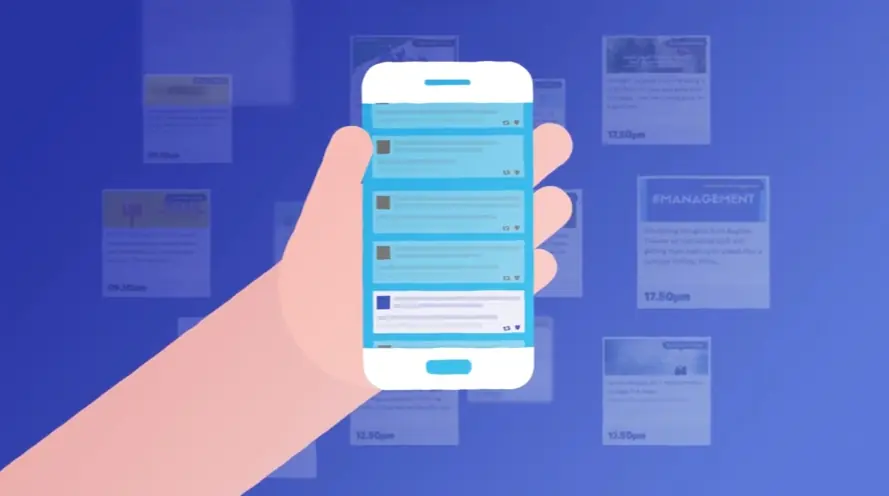In today's digital landscape, capturing and retaining viewers' attention is paramount for any successful video content strategy. With the constant influx of information and the ever-shortening attention spans, creating informative videos that resonate with your audience is more crucial than ever.
Understanding the nuances of creating compelling informative video content is essential for any brand or individual looking to engage and educate their audience. Let's dive in.
Key Takeaways
1. Leica Geo
Leica Geo LOC8 is a fleet management, theft deterrence, and location solution for total stations. The video is designed to showcase the benefits of the LOC8 app and how it can help users track their total stations and deter theft.
Video Design - The video features simple and clean animations, and a bright color palette to highlight the key features of the app. It uses an animated map, with a pin showing the location of the total station. The video also shows how users can set up geofences and receive alerts if the total station leaves the defined area, helping deter theft.
Leica Geo wants to increase app downloads, and this video helps achieve this goal by focusing on the user experience, demonstrating how the app works, and highlighting the benefits of using the app. It also includes a clear call to action, encouraging viewers to visit the website for more information. The video's visual style and engaging narrative make it informative and easy to understand, which helps drive app downloads.
2. Scorebuddy
Scorebuddy is a Contact Center QA solution. The video is designed to demonstrate how Scorebuddy can help organizations improve their contact center quality and performance.
Video Design - Scorebuddy's video is animated with illustrations and utilizes a light and friendly color palette to create a positive and approachable tone. The graphics are simple and engaging, emphasizing the need for an efficient contact center QA solution. The video utilizes bold text to highlight key phrases, like SUPPORT, further emphasizing the core value of the solution.
Scorebuddy wants to increase the visibility of their app and their video plays a vital role in achieving this goal. The video's clear and concise message quickly highlights the problem and solution, making it relatable for a broad audience. The animated style further enhances the accessibility and appeal of the message, encouraging viewers to learn more about Scorebuddy's solution. By effectively showcasing the key benefits and ease of use, the video helps Scorebuddy gain traction and generate interest in their contact center QA app.
3. Imprivata
Imprivata Mobile Access and Control is a solution for organizations who use shared mobile technology. This video is designed to show how Imprivata can help you manage and control shared devices in a secure and personalized way.
Video Design - The video uses a clean and modern design style. It features bold graphics and clear animations, making it easy to understand. A blue background is used to contrast with orange icons and text, which highlights specific benefits of the solution. Imprivata highlights their mobile security solutions by using icons to represent important points, like data privacy, real-time access, and workflows.
Imprivata has successfully achieved its goal of boosting audience engagement. The video's clean and modern design, bold graphics, clear animations, and engaging content create a high-quality video that viewers find informative and easy to understand. The visual elements of the video work together to ensure that viewers will remember Imprivata's solutions for mobile security.
4. Ensono
Ensono helps companies achieve successful business transformation through its intelligent management solution. The video is designed to highlight the challenges of managing a complex IT estate and promote Ensono M.O. as the solution.
Video Design - The video employs a simple yet effective design style, using clean, minimalist graphics and animation. The focus is on the information conveyed rather than flashy visuals, using animated icons, and text to communicate the complexities of managing a hybrid IT environment. The video design is visually appealing and informative, effectively highlighting the challenges of managing a complex IT estate.
Ensono is using this video to increase awareness of the brand and its solution. The video effectively communicates the challenges companies face when managing a diverse IT environment and the risks involved when visibility is limited. Ensono M.O. is presented as the solution to these challenges, effectively promoting the brand and its product while simultaneously increasing awareness of Ensono's capabilities. This style of video helps companies like Ensono increase brand awareness through effective communication and a concise, focused message.
5. Cadence
Cadence is a company that enables electronic systems and semiconductor companies to create innovative products. This video is designed to showcase Cadence's 3D-IC platform, Integrity, which offers solutions for 3D-IC design, analysis and implementation.
Video Design -
The video features a clean, minimalist visual style. It primarily employs 3D animation and graphics to illustrate the complex concepts involved in 3D-IC technology. The video uses various colors and shapes to represent different components and processes, making it visually engaging and easier to understand. The animation is smooth and well-paced, ensuring that the viewers understand each concept without getting overwhelmed. The visuals clearly show the benefits of 3D-IC technology, emphasizing how it allows designers to pack more functionality into smaller form factors.
Cadence successfully achieved the goal of boosting brand engagement by clearly showcasing its innovative platform. The video engages the audience by combining visually appealing 3D graphics and a simple explanation of the 3D-IC technology. The visuals and animation are engaging, while the succinct narrative effectively conveys the complex benefits of the 3D-IC platform.
6. Dolbey
Dolbey is a company that offers a solution to increase productivity in industries such as healthcare, legal, public safety and insurance. The video is designed to showcase how their solution helps to address the challenges faced by professionals in these industries.
Video Design - The video features a minimalist design style that emphasizes the use of flat illustrations. The video uses simple color palette that is easy to understand and visually appealing. This makes it easy for viewers to grasp the concepts being presented.
Dolbey has successfully achieved the goal of boosting brand visibility through this video. The video content is engaging and informative, which helps Dolbey stand out from competitors. By highlighting the challenges faced by professionals and providing a solution, Dolbey effectively communicates its brand value proposition. The video style is visually appealing and the content is relevant to the target audience, which helps in increasing brand awareness.
7. Piller Blowers
Piller Blowers is a company that specializes in blowers and compressors for vapor compression. The video is designed to showcase Piller Blowers' VapoLine product portfolio, highlighting the benefits of Mechanical Vapor Recompression (MVR) applications.
Video Design - The video uses 3D animation to showcase the VapoLine products, featuring a clean and modern visual style with a white background and sharp, defined edges. The product is presented in a clear and informative way with a focus on showcasing the product's features and benefits. The video uses a combination of close-ups and long shots, creating an engaging visual experience.
The video has successfully achieved the goal of boosting click through rate for Piller Blowers by using professional 3D animation, focusing on a specific product line, and including keywords that will attract a relevant audience. The video's clean and modern visual style, along with its informative content, will encourage viewers to learn more about the company and its products. The video's use of visual elements and engaging narrative is likely to capture the attention of the viewer, leading to higher engagement rates and a greater chance of a click through.
8. Comarch
Comarch is a company that offers IT systems and solutions. This video is designed to showcase the company’s capabilities in the field of Artificial Intelligence and how it can help businesses thrive in the digital age.
Video Design - Comarch's video uses a clean and modern aesthetic, blending vibrant colors with a dark blue background. Geometric shapes and animated lines create a sense of motion and progress, symbolizing the speed and efficiency of Comarch's AI solutions. The use of 3D graphics emphasizes the futuristic nature of the technology, further reinforcing its potential to revolutionize business operations.
Comarch has successfully achieved the goal of increasing awareness of its AI capabilities. The video's engaging visual style and concise narrative effectively communicate the benefits of integrating AI into businesses, helping Comarch reach its target audience and promote conversions. By highlighting the potential of AI to improve efficiency, reduce costs, and optimize processes, the video resonates with viewers who are looking for innovative solutions to their business challenges. The video's clear call to action further encourages viewers to learn more about Comarch's offerings, potentially leading to increased conversions and growth for the company.
9. Diuna
Diuna is a language services provider for the world. The video is designed to showcase the company's expertise in translation, helping businesses navigate global markets.
Video Design -
The video design features a minimalist style, using geometric shapes and simple illustrations to represent various business elements, like graphs and documents. This design concept makes the video visually appealing while also emphasizing the straightforward, professional nature of Diuna’s services.
Diuna has successfully achieved the goal of engaging the customer by delivering clear and concise information on the company's services. The simple yet stylish design, combined with the straightforward message and international greetings, effectively communicates the value proposition and the reach of Diuna. The focus on translation needs and the clear visual representation of the core offering enhances customer understanding and helps the company achieve its goal of boosting customer engagement.
10. Bosch Rexroth
Bosch Rexroth is a specialist in hydraulic controls and drive technology for recycling presses. The video is designed to showcase their solutions for forming, baling, and recycling presses.
Video Design - The video utilizes a clear and concise design approach that clearly showcases the hydraulic control and drive technology for recycling presses. The main focus of the video is on the mechanics and the technology, not on the product itself. A transparent model of a recycling press is used, allowing the viewer to see the inner workings of the machine and how the drive technology functions. The video uses a white background to focus attention on the subject matter. The graphics are clean and modern, and the text overlay provides clear information about the features and benefits of the system.
Bosch Rexroth has successfully achieved the goal of increasing the traffic on their landing page, as the video effectively communicates their expertise and the advantages of using their technology. The video emphasizes the efficiency and reliability of their hydraulic control and drive technology, which is critical for convincing potential customers to explore their solutions. The video design makes a complex topic easily understandable for the audience, generating interest and driving them to learn more about the technology and explore the company's website.
The Power of Video Hooks
A video hook is the captivating opening of your video, designed to instantly grab the viewer's attention and entice them to keep watching. In today's digital landscape, where attention spans are fleeting, a compelling hook is crucial for any video's success.
Think of it as the digital equivalent of a captivating opening line in a novel or a powerful first impression. It can take various forms, including a thought-provoking question, a surprising statistic, a visually stunning scene, or even a brief, compelling story.
The key is to make it relevant to your video's topic and resonate with your target audience. A hook for a TikTok video might be humorous and attention-grabbing, while a hook for a B2B explainer video might focus on a specific industry pain point. Ultimately, a strong hook sets the stage for an engaging viewing experience and ensures your message gets heard.
Video Storytelling Styles
Video narratives come in various forms, each with its unique structure and impact on the viewer.
Linear Narrative. This is the most traditional approach, presenting events in a chronological order, much like a classic storybook. It's easy to follow and provides a clear sense of progression.
Non-linear Narrative. This type breaks free from the chronological constraints, jumping between different time periods, often using flashbacks or flash-forwards. Think of movies like Memento, where the non-linear structure adds layers of suspense and intrigue.
Episodic Narrative. This format breaks down a larger story into a series of self-contained episodes, each with its own beginning, middle, and end. Popular TV shows often utilize this structure, allowing for ongoing character development and plot twists.
Circular Narrative. This unique approach brings the story full circle, ending where it began. It can create a sense of closure or highlight the cyclical nature of certain themes.
Choosing the right narrative structure depends on your video's message and the emotional impact you want to create.
Know Your Audience, Know Your Video
Creating impactful video content starts with understanding your audience. Audience research is the key to unlocking insights into their needs, interests, preferences, and pain points.
Imagine trying to hit a target blindfolded – audience research removes the blindfold. It allows you to tailor your video content to resonate deeply with your viewers. By understanding their preferences for video length, style, and topics, you can create videos that are more likely to be watched, shared, and ultimately, achieve your goals.
For example, analyzing comments on competitor videos on YouTube can reveal valuable information about what your target audience finds engaging or lacking. This knowledge can inform your video strategy and help you create content that stands out.
Building a Video Marketing Plan
Implementing a successful Video Marketing Strategy involves a series of well-defined steps.
Define Your Goals. Start by clarifying what you aim to achieve with your videos. Are you looking to increase brand awareness, generate leads, or drive sales?
Identify Your Target Audience. Understand who you're trying to reach with your videos. What are their demographics, interests, and online behavior?
Create a Content Calendar. Plan your video content in advance. This ensures consistency and helps you align your videos with your overall marketing goals.
Produce High-Quality Videos. Invest in good lighting and clear audio. Even if you're using a smartphone, ensure your videos are well-lit and the sound is crisp. Explore free editing software to enhance your videos further.
Promote Your Videos. Share your videos across relevant platforms – social media, your website, email newsletters, and industry-specific forums.
Track Your Results. Monitor video performance metrics like views, watch time, and engagement. Use this data to refine your strategy and improve future videos.
Video Power for B2B Success
Video has emerged as a powerful tool for B2B marketers, offering a range of benefits that can significantly impact your bottom line.
Increased Engagement. Videos are inherently more engaging than text-based content. They capture attention and make complex information more digestible, leading to higher levels of viewer interaction.
Improved Brand Awareness. Videos can help you reach a wider audience and build brand recognition. Sharing videos on platforms like LinkedIn can expose your brand to potential clients and partners.
Enhanced Lead Generation. Video landing pages have been shown to increase conversion rates compared to text-only pages. By incorporating compelling videos, you can capture more leads and nurture them through the sales funnel.
Improved Customer Retention. Videos can foster stronger relationships with your customers. Use video tutorials, customer testimonials, and behind-the-scenes content to build trust and loyalty.
Crafting High-Quality Business Videos
Creating a high-quality video doesn't necessarily require a Hollywood budget. With careful planning and attention to detail, you can produce professional-looking videos that effectively communicate your message.
Start with a Strong Script. A well-written script is the foundation of a compelling video. Clearly outline your message, key points, and desired call to action.
Use High-Quality Visuals. Invest in good lighting – natural light or affordable LED panels can make a big difference. Consider using a DSLR camera for sharper footage, or maximize the capabilities of your smartphone camera. Explore free stock footage websites for supplementary visuals.
Add Engaging Music and Sound Effects. Music and sound effects can enhance the emotional impact of your video. Choose royalty-free music that complements your message and enhances the viewing experience.
Optimize for Different Platforms. Ensure your video is formatted correctly for various platforms like YouTube, LinkedIn, and Facebook. Pay attention to aspect ratios and video length recommendations for each platform.
Planning a Winning Video Campaign
A successful video marketing campaign requires careful planning to ensure your efforts align with your overall marketing goals and resonate with your target audience.
Define Your Campaign Goals. Clearly outline what you want to achieve with your campaign. Are you aiming to increase brand awareness, drive website traffic, or generate leads?
Identify Your Target Audience. Understand the demographics, interests, and online behavior of your ideal viewers. This will inform your content strategy and platform selection.
Create a Content Calendar. Plan your video content in advance, ensuring a consistent flow of engaging videos throughout your campaign.
Set a Budget. Determine how much you can realistically invest in your campaign, considering factors like video production, promotion, and analytics tools.
Choose the Right Platforms. Select the platforms where your target audience is most active. A campaign targeting a younger demographic might prioritize TikTok and Instagram, while a B2B campaign might focus on LinkedIn.
Track Your Results. Monitor key metrics like views, engagement, and conversions. Use this data to optimize your campaign and improve future efforts.
Video for Conversion Optimization
Video can be a powerful tool for driving conversions, turning viewers into customers or leads.
Include a Clear Call to Action. Tell viewers exactly what you want them to do – visit your website, sign up for a newsletter, or request a demo.
Use Persuasive Language. Craft your video script with compelling language that highlights the benefits of taking action.
Highlight the Benefits of Converting. Clearly demonstrate how taking the desired action will benefit the viewer. For example, if you're promoting a software product, showcase its features and how it solves a specific problem.
Make it Easy to Convert. Provide clear instructions and a simple conversion process. If you're directing viewers to a landing page, ensure it's easy to navigate and the conversion form is straightforward.
For example, a product demo video could conclude with an end screen featuring a clickable button that takes viewers directly to a free trial signup page.
Engaging Viewers with Video
Creating engaging video content requires a combination of techniques that capture attention and keep viewers hooked.
Start with a Strong Hook. Grab viewers' attention from the very beginning with a compelling question, a surprising statistic, or a visually stunning scene.
Use Storytelling. Weave a narrative that resonates with your audience. Share a personal anecdote, a customer success story, or a relatable challenge that your product or service helps overcome.
Ask Questions. Encourage viewers to think and participate by posing questions throughout your video. This can be done directly to the camera or through interactive elements like polls or quizzes.
Use Humor. Injecting humor into your videos can make them more memorable and shareable. However, ensure the humor is appropriate for your brand and target audience.
Include Visuals. Use high-quality visuals to illustrate your points and keep viewers engaged. Consider using animations, graphics, or b-roll footage to break up talking head shots.
Keep it Concise. Respect your viewers' time by keeping your videos concise and to the point. Deliver your message effectively without unnecessary fluff.
Video Power for Sales Teams
Video can be a valuable asset for your sales team, empowering them to connect with prospects, build relationships, and close deals more effectively.
Create Product Demos. Showcase your product's features and benefits in action. A well-crafted product demo video can be a powerful tool for sales presentations and online marketing.
Develop Case Studies. Highlight how your product or service has helped other businesses achieve success. Video case studies can provide compelling social proof and build trust with potential clients.
Produce Testimonials. Feature satisfied customers sharing their positive experiences with your product or service. Testimonial videos can be highly persuasive and build credibility.
Offer Training Videos. Equip your sales team with the knowledge and skills they need to succeed. Create training videos that cover product information, sales techniques, and best practices.
For instance, a sales representative could send a prospect a link to a relevant case study video before a meeting to provide context and demonstrate the value proposition.
Types of Video Marketing Content
The versatility of video allows for a wide range of content types, each serving a specific marketing purpose.
Product Demos. Showcase your product's features, benefits, and functionality in a clear and engaging way.
Explainer Videos. simplify complex concepts or processes through animated visuals and concise explanations.
Case Studies. Highlight real-world examples of how your product or service has helped other businesses achieve success.
Testimonials. Feature satisfied customers sharing their positive experiences, building trust and credibility.
Behind-the-Scenes Videos. Give viewers a glimpse into your company culture, values, and the people behind your brand.
How-to Videos. Provide valuable information and guidance to your audience, positioning your brand as a helpful resource.
Social Media Videos. Create short, engaging videos optimized for different social media platforms to increase brand awareness and engagement.
Video for Every Marketing Need
Video's adaptability makes it a valuable tool for various business needs beyond traditional marketing.
Product Launches. Generate excitement and anticipation for new product releases through teaser videos and launch day announcements.
Customer Onboarding. Welcome new customers and guide them through your product or service with tutorial videos and welcome messages.
Employee Training. Educate employees on new policies, procedures, or product updates through engaging video modules.
Marketing Campaigns. Promote your brand, products, or services through targeted video ads, social media campaigns, and website content.
Customer Support. Provide quick and easy answers to common customer questions through video tutorials and FAQs.
For example, a company launching a new software product could create a series of videos, starting with a teaser video to generate buzz, followed by a product demo video on launch day, and then a series of tutorial videos to help users get started.
Targeting Your Video Audience
Creating a video that resonates with your target audience requires careful consideration of their unique characteristics and preferences.
Understand Their Needs and Interests. Research your target audience to identify their pain points, challenges, and aspirations. What are they looking for in a product or service like yours?
Choose the Right Format and Style. Tailor the video format and style to your audience's preferences. A video targeting teenagers might use fast cuts, trendy music, and vibrant visuals, while a video targeting senior citizens might use a slower pace, calming music, and clear, concise messaging.
Use Appropriate Language and Tone. Speak your audience's language and adopt a tone that resonates with them. Avoid jargon or technical terms that might alienate viewers.
Include Relevant Visuals and Music. Choose visuals and music that appeal to your target audience's aesthetic preferences and cultural background.
Storytelling Through Video
Storytelling is a powerful tool for engaging viewers and making your videos memorable.
Establish a Clear Beginning, Middle, and End. Structure your video like a classic story with a clear introduction, rising action, climax, falling action, and resolution.
Introduce Compelling Characters. Create relatable characters that your audience can connect with. These characters can be real people (e.g., customers, employees) or fictional representations of your target audience.
Create Conflict and Resolution. Introduce a challenge or conflict that your characters face and then demonstrate how your product or service helps them overcome it.
Use Visuals and Music to Enhance the Story. Choose visuals and music that evoke the desired emotions and immerse viewers in the story.
For example, a video could tell the story of a small business owner struggling to manage their inventory. The video could then introduce your inventory management software as the solution that helps the business owner streamline their operations and achieve success.
Video for Customer Onboarding
Video can significantly enhance the customer onboarding experience, leading to increased engagement, retention, and satisfaction.
Improved Engagement. Videos are more engaging than text-based onboarding materials. They can capture attention and make the learning process more enjoyable.
Increased Retention. Videos can help customers learn and retain information more effectively. Visual demonstrations and step-by-step guides can improve understanding and reduce confusion.
Enhanced Customer Satisfaction. A smooth and engaging onboarding experience can lead to higher levels of customer satisfaction. Videos can make the process more efficient and user-friendly.
Reduced Support Costs. By providing clear and comprehensive video tutorials, you can reduce the need for customer support inquiries, saving your business time and resources.
For instance, a software company could create a series of onboarding videos that walk new users through the key features of the platform, reducing the learning curve and increasing the likelihood of product adoption.
Video for Customer Retention
Video can be a powerful tool for nurturing customer relationships and fostering loyalty.
Create Educational Videos. Provide customers with valuable information that helps them get the most out of your product or service. Create tutorial videos, tips and tricks videos, and FAQ videos.
Share Customer Success Stories. Showcase how your product or service has helped other businesses achieve their goals. These stories can inspire and motivate existing customers.
Offer Exclusive Content. Provide customers with access to exclusive video content, such as webinars, behind-the-scenes footage, or early access to new product features.
Provide Personalized Support. Use video to address customer questions or concerns in a personalized and engaging way. Create custom video responses or offer video chat support.
By providing ongoing value and support through video, you can build stronger relationships with your customers and increase their likelihood of staying with your brand.
Building a Video Marketing Funnel
A successful video marketing funnel strategically guides viewers through a series of stages, ultimately leading them towards conversion. Each stage requires a specific type of video content tailored to the viewer's mindset.
Awareness. At this initial stage, the goal is to introduce your brand and capture the attention of a broad audience. Engaging, shareable content like short, attention-grabbing social media videos or explainer videos that highlight a problem your product solves are effective.
Consideration. Once viewers are aware of your brand, provide them with valuable information to educate them about your offerings. Explainer videos delving deeper into your product's features, benefits, and how it compares to competitors are valuable here.
Decision. Now, it's time to nudge viewers towards making a purchase. Product demos, customer testimonial videos showcasing positive experiences, and comparison videos highlighting your product's advantages can be highly persuasive.
Action. Finally, make it incredibly easy for viewers to take the desired action. Include clear and compelling calls to action in your videos, directing viewers to your website, landing page, or a special offer.
By crafting video content specifically for each stage of the funnel, you can effectively nurture viewers from initial awareness to becoming loyal customers.
Video in Multi-Channel Marketing
Integrating video across your marketing channels creates a cohesive and engaging brand experience. Here's how to leverage video effectively on different platforms:
Social Media. Share short, visually appealing videos on platforms like Instagram and TikTok. Think behind-the-scenes glimpses, product teasers, or quick tips related to your industry. Utilize features like Instagram Reels or Facebook Live for real-time engagement.
Email Marketing. Boost your email open and click-through rates by embedding videos or including eye-catching thumbnails that link to video content. Welcome videos, product updates, or personalized messages can significantly enhance your email campaigns.
Website. Embed videos strategically on your website's landing pages, product pages, or about us section. Product demos, customer testimonials, or explainer videos can improve user understanding and engagement.
Paid Advertising. Utilize video ads on platforms like YouTube and social media to reach a wider audience. Create targeted video ads that address specific audience segments and their needs.
Events. Capture event highlights, speaker presentations, or attendee testimonials through video. Share these videos on social media and your website to extend the reach of your events and provide valuable content to attendees.
Video on Social Media Best Practices
Social media thrives on short, engaging content. To maximize the impact of your videos, tailor your approach to each platform:
Keep it Concise. Capture attention quickly with videos under 60 seconds, especially on platforms like TikTok and Instagram.
Visually Captivating. Use high-quality visuals, bright colors, and dynamic editing to make your videos stand out in crowded feeds.
Platform Optimization. Understand the unique format requirements of each platform. Create vertical videos for TikTok and Instagram Stories, while landscape format may be better suited for YouTube.
Strong Call to Action. Clearly tell viewers what you want them to do – visit your website, like the video, follow your page, etc.
Hashtag Relevance. Use relevant hashtags to increase the discoverability of your videos. Research trending hashtags in your industry and incorporate them strategically.
Engage with Comments. Respond to comments and questions from viewers to foster a sense of community and build relationships.
Video for Brand Awareness
Video is a powerful tool for building brand awareness and creating a lasting impression on your target audience.
Brand Story Videos. Craft compelling videos that showcase your company's mission, values, and culture. Give viewers a behind-the-scenes look at your company and what makes you unique.
Customer Success Stories. Feature satisfied customers sharing their positive experiences with your product or service. These authentic testimonials build trust and credibility.
Social Media Contests. Encourage user-generated content by running video contests. Ask viewers to create videos related to your brand and offer prizes for the best submissions.
Influencer Collaborations. Partner with relevant influencers in your industry to create sponsored videos that reach a wider audience and leverage the influencer's established credibility.
By consistently creating and sharing high-quality videos that resonate with your target audience, you can effectively build brand awareness and establish a strong brand presence.
Measuring Video Marketing Success
Measuring the effectiveness of your video marketing campaigns is crucial for optimizing your strategy and achieving your goals. Key metrics to track include:
Views and Watch Time. Monitor the number of views your videos receive and the average watch time. This indicates audience interest and engagement. Tools like YouTube Analytics provide detailed insights into viewer behavior.
Engagement Metrics. Track likes, comments, shares, and click-through rates. These metrics reveal how actively viewers are interacting with your content and whether it resonates with them.
Conversions. Measure how many viewers take the desired action after watching your video, such as signing up for a newsletter, making a purchase, or requesting a demo. This directly reflects the impact of your videos on your business goals.
Website Traffic. Analyze referral traffic from video platforms to your website. This indicates whether your videos are effectively driving viewers to learn more about your brand or offerings.
Brand Awareness. Monitor brand mentions and social media sentiment related to your videos. This helps gauge the impact of your videos on brand perception and reach.
Video for Lead Generation
Video can be a highly effective lead generation tool when combined with strategic calls to action and valuable content offers.
Create Compelling Lead Magnets. Offer viewers valuable resources in exchange for their contact information. This could be a free e-book, webinar access, discount code, or exclusive video content.
Clear and Concise CTAs. Tell viewers exactly what you want them to do – download a guide, sign up for a free trial, or visit your website. Make your CTAs prominent and easy to follow.
Dedicated Landing Pages. Direct viewers from your videos to dedicated landing pages where they can learn more about your offer and easily submit their information through a form.
Example. A software company creates a video showcasing the benefits of their project management tool. At the end of the video, they include a clear CTA to download a free project planning template by visiting a dedicated landing page.
By providing valuable content and making it easy for viewers to convert, you can effectively generate leads and nurture them through your sales funnel.
Industry-Specific Video Marketing
When creating videos for a specific industry, it's essential to tailor your approach to resonate with the target audience and address their unique needs and challenges.
Industry Research. Thoroughly research the industry to understand its trends, challenges, and language. This will help you create relevant and informative content.
Target Audience. Clearly define your target audience within the industry. Consider their demographics, interests, and pain points to create videos that address their specific needs.
Industry-Specific Language. Use terminology and language that is familiar to your target audience. Avoid jargon that may confuse or alienate viewers.
Relevant Visuals. Incorporate visuals that are relevant to the industry and resonate with the target audience. For example, a video for the construction industry might feature footage of building projects and construction equipment.
Example. A healthcare company creating a video about a new medical device would use clear and concise language, avoiding complex medical jargon. They would also incorporate visuals of the device in use and testimonials from medical professionals.
Video for Customer Experience
Video can significantly enhance customer experience by providing valuable information, personalized support, and engaging interactions.
Educational Videos. Create tutorials, how-to guides, and FAQ videos that empower customers to use your products or services effectively. This reduces the need for customer support inquiries and improves self-service capabilities.
Personalized Video Messages. Use video to deliver personalized welcome messages, onboarding instructions, or support responses. This adds a human touch and strengthens customer relationships.
Customer Success Stories. Showcase how your products or services have helped other customers achieve their goals. These stories build trust and demonstrate the value of your offerings.
Example. An online retailer creates a series of short videos demonstrating how to assemble different furniture items. These videos are easily accessible on product pages and provide customers with clear visual instructions, improving their overall experience.
Video in Email Marketing
Integrating video into your email marketing campaigns can significantly increase engagement and drive conversions.
Compelling Subject Lines. Mention "video" in your subject line to pique recipients' curiosity and increase open rates.
Optimized Thumbnails. Use an eye-catching thumbnail image that accurately represents your video content and encourages clicks.
Mobile-Friendly Format. Ensure your videos are optimized for viewing on mobile devices, as a significant portion of emails are opened on smartphones.
Clear Call to Action. Include a clear and concise call to action within the email and in the video itself, directing viewers to your website or landing page.
Example. A travel agency sends an email promoting a new tour package. The email subject line mentions a "video tour" and includes a visually appealing thumbnail of a scenic destination. The email and video both contain a clear CTA to book the tour on their website.
Video for Strong Calls to Action
A strong call to action (CTA) is crucial for converting video viewers into customers.
Persuasive Language. Use action-oriented verbs and language that creates a sense of urgency or excitement. Phrases like "Get started today," "Limited-time offer," or "Learn more now" can be effective.
Highlight Benefits. Clearly communicate the benefits of taking action. What will viewers gain by clicking your link, signing up for your newsletter, or making a purchase?
Easy Conversion Path. Make it as easy as possible for viewers to convert. Provide clear instructions and a simple conversion process, such as a prominent button or link.
Visual Cues. Use visual elements like arrows, animations, or highlighted text to draw attention to your CTA.
Example. A fitness company creates a video showcasing their online workout program. At the end of the video, a brightly colored button appears with the text "Start your free trial now," accompanied by an animated arrow pointing to the button.
Winning Video Marketing Strategy
A successful video marketing strategy requires careful planning and execution.
Clearly Defined Goals. Start by defining your objectives. Do you want to increase brand awareness, generate leads, drive sales, or improve customer engagement?
Target Audience Identification. Understand your target audience's demographics, interests, and preferences to create videos that resonate with them.
Compelling Content Creation. Produce high-quality videos that are engaging, informative, and entertaining. Tailor your content to each stage of the buyer's journey.
Effective Distribution. Share your videos on the platforms where your target audience spends their time. This could include YouTube, social media, your website, or email marketing.
Performance Monitoring and Optimization. Track key metrics like views, engagement, and conversions to measure the success of your videos and identify areas for improvement.
Video for Customer Journey Optimization
Video can enhance the customer journey at every stage, from initial awareness to post-purchase engagement.
Awareness. Introduce your brand and products through engaging explainer videos or social media content that captures attention and sparks interest.
Consideration. Provide in-depth product demos, educational videos, and comparison guides to help customers evaluate your offerings and understand their benefits.
Decision. Showcase customer testimonials, case studies, and behind-the-scenes videos to build trust and confidence in your brand.
Action. Include clear calls to action in your videos to encourage customers to make a purchase, sign up for a free trial, or request a demo.
Retention. Create personalized thank you videos, onboarding tutorials, and exclusive content for existing customers to foster loyalty and encourage repeat business.
Video for Micro Interactions
Micro-interactions are small, engaging actions that encourage viewers to actively participate with your video content.
Interactive Questions. Pose questions throughout your videos to prompt viewers to think and respond in the comments section.
Polls and Quizzes. Incorporate polls or quizzes within your videos to gather feedback, assess viewer understanding, and encourage active participation.
Clickable Annotations. Use clickable annotations to link to relevant resources, product pages, or other videos, allowing viewers to explore further.
Live Q&A Sessions. Host live Q&A sessions on platforms like YouTube or Facebook Live to interact with viewers in real-time and answer their questions.
Example. A cooking channel creates a video demonstrating a new recipe. They include a poll asking viewers which variation of the recipe they'd like to see next, encouraging interaction and providing valuable feedback.
Video for Brand Identity
Video is a powerful tool for communicating your brand's personality, values, and visual identity.
Consistent Visuals. Use consistent branding elements like colors, fonts, and logos across all your videos to create a cohesive brand experience.
Unique Video Style. Develop a distinctive video style that reflects your brand's personality. This could involve using specific editing techniques, music choices, or animation styles.
Brand Story Videos. Create videos that tell your brand's story, highlighting your mission, values, and the people behind your company.
Customer-Focused Content. Showcase customer stories and testimonials to demonstrate your brand's commitment to customer satisfaction.
Example. A tech startup uses a consistent color palette, modern font, and upbeat music in all their videos, creating a recognizable and energetic brand identity.
A/B Testing with Video
A/B testing allows you to compare different versions of your videos to determine which elements resonate best with your audience.
Test Different Hooks. Experiment with different video introductions or "hooks" to see which ones capture viewers' attention most effectively.
Vary Calls to Action. Test different CTAs to identify which wording, placement, or design drives the most conversions.
Experiment with Video Length. Compare the performance of shorter versus longer videos to determine the optimal length for your target audience.
Analyze Results. Track key metrics like click-through rates, watch time, and conversions for each variation to determine which version performs best.
Example. A company testing two versions of a product demo video might find that the version with a stronger CTA at the end results in significantly higher conversion rates.
Video for Customer Support
Video can be a valuable resource for your customer support team, providing quick and accessible solutions to common customer issues.
FAQ Videos. Create videos that answer frequently asked questions about your products or services. This reduces the volume of support inquiries and empowers customers to find answers independently.
Product Tutorials. Develop video tutorials that guide customers through using your products or services effectively. This can cover everything from basic setup to advanced features.
Troubleshooting Guides. Create videos that address common troubleshooting issues, providing step-by-step instructions to help customers resolve problems on their own.
Personalized Support Videos. Use video to deliver personalized support responses to specific customer inquiries, adding a human touch and improving customer satisfaction.
Example. A software company creates a series of short videos demonstrating how to use different features of their software. These videos are easily accessible through a knowledge base or help center, providing customers with instant support.









